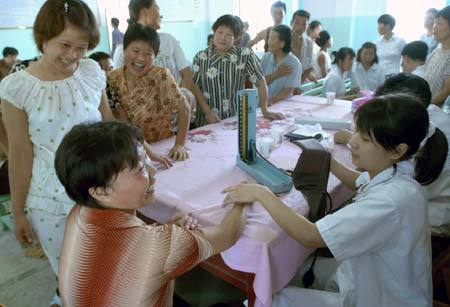VIII-6 Question: China is a vastly populous nation with a low per capita income and a stringent state budget. Its healthcare and insurance system, therefore, can merely offer people the most basic medical services. With respect to a healthcare safety network stretching to every citizen, what measures can we expect the government to adopt?
A: China is home to a population of 1.3 billion; however, it has a relatively low income per capita, and low overall state revenues. While the government is determined to address the issue of medical system reform, it needs to necessarily learn from the experience of foreign governments, which have made remarkable achievements in this arena. On the other hand, it is needed to keep China's reality in mind. China endeavors to offer every citizen basic medical services, narrow down the gap between developed and undeveloped areas, and to steer the country's current medical care network towards a regulated system which will provide her people timely diagnoses, safe prescriptions, and medical services at affordable costs.
In 1997, the Central Government worked out a goal to establish a healthcare system covering every citizen. And through years of great effort, it has established an urban medical insurance system and a new rural cooperative healthcare system that is accessible to more people. Despite this, some local governments are shortsighted enough to run hospitals or clinics under the contracting or corporate system instead of putting them on welfare. Market pressure and favor in profits have made medical costs continuously float up and increasingly unaffordable to ordinary people.
China's actual situation - economic status, financial budget and state revenue - demand the joint efforts of governmental expenditure, social funds, and individual payments to ensure that everyone may enjoy good medical and healthcare services. Economically, the reform should follow rules of development. Internationally, a market-oriented medical service system does not exist in any country so far, and China implements a system partly covered by social welfare and public commonwealth. In a bid to make medical services reachable to more people, in the long run China will focus on the establishment of a multiple-level healthcare network covering both rural and urban areas with management assistance on pharmaceuticals and state-run hospitals.
Actually, China's booming economy and state revenue bolster an ever-increasing input in the construction of the medical system, a public healthcare network, rural cooperative medical care network, the improvement of rural hygiene, community medical services, and the prevention and monitoring of deadly diseases. 2006 statistics revealed that state budgets on medical expenses doubled compared to those in 2002, and central expenditure on these dramatically increased in 2007, up 86 percent year-on-year. These funds invested will be conducive to constructing a more complete medical service network, under which both urbanites and rural people can share the benefits of social welfare.

(China.org.cn)